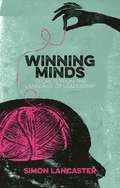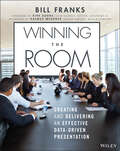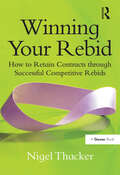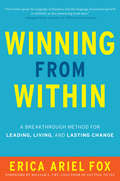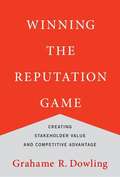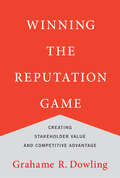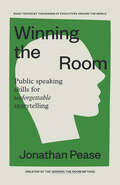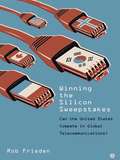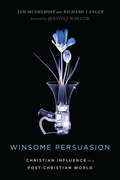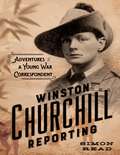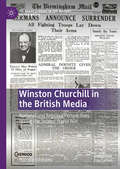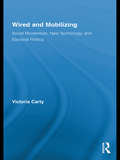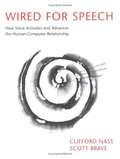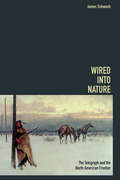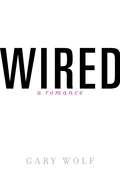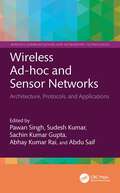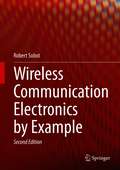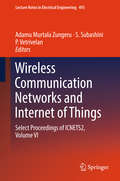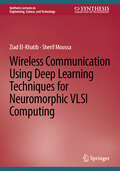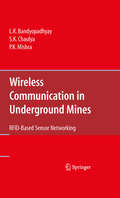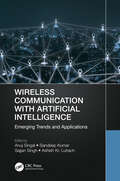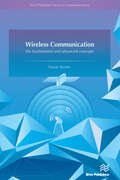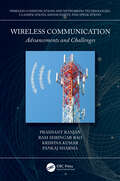- Table View
- List View
Winning Minds: Secrets from the Language of Leadership
by Simon LancasterShhh. Did you know there is a secret Language of Leadership: a timeless set of cues and signals that still determines who reaches the top in politics and business today? The ancient Greeks were the first to study the art of communication 2,500 years ago. It is only now, with recent breakthroughs in neuroscience, that we can say for sure what works and how. In Winning Minds, top speechwriter Simon Lancaster blends ancient rhetoric and neuroscience to create the definitive guide to the Language of Leadership. With trust in business and political leaders at record lows, there's never been a better time for a fresh perspective on communication. Winning Minds is packed with insights into the effects of metaphors, stories and sound bites on the brain. We know what the brain looks like on heroin. This audiobook shows the brain on Branson, Obama and Boris.
Winning Nice: How To Succeed In Business and Life Without Waging War
by Dawna Stone Matt DieterRadio show host and founder of Her Sports + Fitness magazine, Dawna Stone shares her recipe for personal and professional success. A successful executive, entrepreneur, athlete, and public speaker, Dawna Stone credits her incredible success to a simple formula: be nice and treat people with respect. Her refreshing, straightforward approach and insights inspire and motivate women to be themselves while succeeding in business and in life. Using real-life anecdotes and actionable tips from her personal experiences, Stone presents 10 steps to developing interpersonal skills. WINNING NICE demonstrates how to build an empowered team, how to both lead and follow, and how to handle the toughest situations--including firing employees, sexual harassment, and negative coworkers. Readers will reap exponential rewards as they progress through their business career just by being nice.
Winning The Room: Creating and Delivering an Effective Data-Driven Presentation
by Bill FranksRevolutionize your data-driven presentations with this simple and actionable guide In Winning The Room: Creating and Delivering an Effective Data-Driven Presentation, analytics and data science expert Bill Franks delivers a practical and eye-opening exploration of how to present technical data and results to non-technical audiences in a live setting. Although framed with examples from the analytics and data science space, this book is perfect for anyone expected to present data-driven information to others. The book offers various specific tips and strategies that will make data-driven presentations much clearer, more intuitive, and easier to understand. Readers will discover: How to avoid common mistakes that undercut a presentation's credibility Instructive and eye-catching visuals that illustrate how to drive a presenter's points home and help the reader to retain the information Specific and actionable techniques to dramatically improve a presentation's clarity and impact Ideal for anyone expected to present to managers, executives, and other business leaders, Winning The Room is required reading for everyone seeking to improve the quality and efficacy of their data-driven presentations and communications.
Winning Your Rebid: How to Retain Contracts through Successful Competitive Rebids
by Nigel ThackerLosing contracts at rebid can have a major impact on a business: the loss of turnover and profit, of customers, skills, people and potentially reduced morale and confidence. Investment in retaining rebids can underpin significant increases in growth, at a lower cost than focussing only on chasing new business. Average retention rate of contracts at rebid is 60-70% across many companies, with others retaining as little as 50%, or less. However, there are proven approaches that can improve any company's chances of winning. Winning Your Rebid will help incumbent contractors increase their chances of retaining an existing contract. Whilst it includes the skills of bidding for new contracts, rebidding requires a significantly different set of actions and processes. The book takes you through all the preparations throughout a contract that will put you in the best position to win your rebid and includes valuable advice, techniques, case studies and ideas on how to run and deliver it successfully.
Winning from Within
by Erica Ariel FoxLife is a series of negotiations, whether or not you think of yourself as a negotiator . From seemingly insignificant daily decisions to major life choices, you negotiate every time you aim to persuade, argue over a decision, or resolve a conflict. But as negotiations and leadership expert Erica Ariel Fox reveals, the most important negotiations--the ones that determine the impact of our actions and the quality of our lives--are those we have with ourselves. Most of us recognize the difference between our knowledge--what we know we should do and say--and our knowhow--what we actually do and say in real life when it counts. Fox calls this the "Performance Gap," and she shows you how to close it, turning breakdowns into breakthroughs, whether struggling with a difficult client, arguing with a combative teenager, or organizing for community action. Winning from Within combines insights from Western psychology and Eastern philosophy with practical applications from real business situations and everyday life. Fox shows that the ability to achieve mastery over how we interact with each other comes from within, from the "center" where desires, thoughts, feelings, and impulses to take action live side-by-side. Winning from Within offers a profound and highly practical seven-step method for making changes that last--at work and at home.
Winning the Reputation Game: Creating Stakeholder Value and Competitive Advantage
by Grahame R. DowlingWhat does a company have to do to be admired and respected? Why does Apple have a better reputation than, say, Samsung? In Winning the Reputation Game, Grahame Dowling explains. Companies' reputations do not derive from consultant-recommended campaigns to showcase efforts at corporate transparency, environmental sustainability, or social responsibility. Companies are admired and respected because they are "simply better" than their competitors. Companies that focus on providing outstanding goods and services are rewarded with a strong reputation that helps them gain competitive advantage.Dowling, who has studied corporate reputation--building for thirty years, describes two core strategies for creating a corporate reputation that will provide a competitive advantage: to be known for being Best at Something or for being Best for Somebody. Apple, for example, is best at personal technology products that enhance people's lifestyles. IKEA is best for people who want well-designed furniture at affordable prices. Dowling covers such topics as the commercial value of a strong reputations -- including good employees, repeat customers, and strong share price; how corporate reputations are formed; the power of "being simply better"; the effectiveness of corporate storytelling (for good or ill; Kenneth Lay of Enron was a master storyteller); and keeping out of trouble.Drawing on many real-world examples, Dowling shows how companies that are perceived to be better than their competitors build strong reputations that reflect past success and promise more of the same. Companies that artificially engineer a reputation with irrelevant activities but have stopped providing the best products and services available often wind up with mediocre -- or worse -- reputations.
Winning the Reputation Game: Creating Stakeholder Value and Competitive Advantage
by Grahame R. DowlingCore strategies for creating a corporate reputation that will provide a competitive advantage in the marketplace: a back-to-basics approach. What does a company have to do to be admired and respected? Why does Apple have a better reputation than, say, Samsung? In Winning the Reputation Game, Grahame Dowling explains. Companies' reputations do not derive from consultant-recommended campaigns to showcase efforts at corporate transparency, environmental sustainability, or social responsibility. Companies are admired and respected because they are “simply better” than their competitors. Companies that focus on providing outstanding goods and services are rewarded with a strong reputation that helps them gain competitive advantage. Dowling, who has studied corporate reputation–building for thirty years, describes two core strategies for creating a corporate reputation that will provide a competitive advantage: to be known for being Best at Something or for being Best for Somebody. Apple, for example, is best at personal technology products that enhance people's lifestyles. IKEA is best for people who want well-designed furniture at affordable prices. Dowling covers such topics as the commercial value of a strong reputations—including good employees, repeat customers, and strong share price; how corporate reputations are formed; the power of “being simply better”; the effectiveness of corporate storytelling (for good or ill; Kenneth Lay of Enron was a master storyteller); and keeping out of trouble. Drawing on many real-world examples, Dowling shows how companies that are perceived to be better than their competitors build strong reputations that reflect past success and promise more of the same. Companies that artificially engineer a reputation with irrelevant activities but have stopped providing the best products and services available often wind up with mediocre—or worse—reputations.
Winning the Room: Public Speaking Skills for Unforgettable Storytelling
by Jonathan PeaseStoryteller Skills for Speeches, Pitch Meetings, and Everyday Life “Raw, funny and hugely practical—JP shares insights and secrets from decades of helping an incredible range of people tell their story with confidence and style. Now you can too.”—Adam Spencer, Australian comedian, media personality and prolific authorTransform into a powerful public speaker that audiences love! For entrepreneurs, creatives, or anyone who needs to communicate authentically with their audience, Winning the Room is the public speaking book for you.Win in every room. Cultivate an authentic connection with your audience, no matter what. Conquer your public speaking fears, learn how to be likable, how to present for work, how to give compelling pitch meetings, and how to be a person who wins through highly effective communication techniques. Winning the Room teaches public speaking skills applicable to everybody, in any situation. Become a great public speaker with guidance from an expert. Do you get nervous before a presentation? Do you find yourself rambling and losing your point? In Winning the Room, award winning creative and communications director, thought leader, and author Jonathan Pease (JP) uses road-tested techniques to take you on a fun, yet practical journey to becoming a fearless storyteller people buy from—emotionally and financially.In Winning the Room, find:A tight, actionable, and memorable system for how to build trust and be great at different types of public speaking momentsHow to turn nervous energy into passion and charisma that people engage withHow to apply these skills to various settings like keynotes, pitch meetings, presentations, and everyday conversations with friends and familyIf you liked Cues, Everyday Business Storytelling, or Your Story Well Told, you’ll love Winning the Room.
Winning the Silicon Sweepstakes: Can the United States Compete in Global Telecommunications?
by Rob FriedenIn this timely book, Rob Frieden points out the many ways the United States has fallen behind other countries in telecommunications and broadband development. Despite the appearance of robust competition and entrepreneurism in U. S. markets, there is very little of either. Because of an inattentive Congress and a misguided FCC unwilling to confront real problems, industry incumbents can earn healthy profits while keeping the United States in the backwaters of Internet-based information, communication, and entertainment markets. At every turn, regulators have tipped the scales in favor of large established companies, creating an environment that stifles innovation. As a consequence, Americans are stuck with relatively slow connectivity and with equipment that lacks features that have been staples in other countries for years. In telecommunications, the United States is a little like a third world country that is developing under crushing bureaucracies without recognizing that the rest of the world has passed it by. Professor Frieden not only shows how failure can intrude on the ability of the United States to compete but suggests how to restore its competitiveness.
Winsome Persuasion: Christian Influence in a Post-Christian World
by Quentin J. Schultze Tim Muehlhoff Richard LangerHow are Christians viewed in the broader culture?Winsome Persuasion
Winston Churchill Reporting: Adventures of a Young War Correspondent
by Simon ReadCombat, cigars, and whiskey--from the jungles of Cuba and the mountains of the Northwest Frontier, to the banks of the Nile and the plains of South Africa, comes this action-packed tale of Winston Churchill's adventures as a war correspondent in the Age of Empire.
Winston Churchill at the Telegraph
by Dr Warren Dockter And Boris JohnsonThis fascinating collection of reportage chronicles the Prime Minister’s life through the newspaper where he began his career.The Telegraph had a uniquely close connection with Winston Churchill at every stage of his life. Beginning with his early days as a war correspondent for the paper, the association continued as he himself became the news—reported on in its pages at every stage of his historic political career.Collected here, for the first time, is the best reportage on this complex man. Unencumbered by the legendary status he would later acquire, there is praise and blame in equal measure: finding space for both dramatic accounts of his wartime premiership and affectionate reports on the animals living at Chartwell, his country estate.The Telegraph was also a happy home for Churchill the journalist, and featured within are many pieces written in his unmistakable prose. Capturing the urgency of the time in which he lived, Churchill at the Telegraph is a celebration of an intimate relationship that lasted over sixty years and shows Winston Churchill in all his paradoxical glory.
Winston Churchill in the British Media: National and Regional Perspectives during the Second World War (Palgrave Studies in the History of the Media)
by Hanako IshikawaThe book explores how Churchill was portrayed in the UK press during the Second World War, comparing his depictions in Scottish, Welsh, Northern Irish, and provincial English newspapers. By using a variety of newspapers from these areas, it examines local opinions about Churchill at the time he was the wartime prime minister. It analyses how Churchill was received and depicted by newspapers in the UK and why differences in these depictions emerged in each area. It contributes to the study of public opinion in the war and of Churchill’s reputation, of the British media, as well as to the study of the notion of Britishness, focusing on local perspectives.
Wired and Mobilizing: Social Movements, New Technology, and Electoral Politics (Routledge Studies in Science, Technology and Society)
by Victoria CartyThis book highlights how online networking offers potential for new forms of activist mobilizing, repertoires, participatory democracy, direct action, fundraising, and civic engagement. It calls for a re-conceptualization of some of the main tenets of contentious and electoral politics, which were originally constructed to describe and analyze face-to-face forms of mobilization, in order to more accurately analyze contemporary forms of protest, electoral processes, and civil society organizing.
Wired for Speech: How Voice Activates and Advances the Human-Computer Relationship
by Clifford Nass Scott BraveInterfaces that talk and listen are populating computers, cars, call centers, and even home appliances and toys, but voice interfaces invariably frustrate rather than help. In Wired for Speech, Clifford Nass and Scott Brave reveal how interactive voice technologies can readily and effectively tap into the automatic responses all speech -- whether from human or machine -- evokes. Wired for Speech demonstrates that people are "voice-activated": we respond to voice technologies as we respond to actual people and behave as we would in any social situation. By leveraging this powerful finding, voice interfaces can truly emerge as the next frontier for efficient, user-friendly technology. Wired for Speech presents new theories and experiments and applies them to critical issues concerning how people interact with technology-based voices. It considers how people respond to a female voice in e-commerce (does stereotyping matter?), how a car's voice can promote safer driving (are "happy" cars better cars?), whether synthetic voices have personality and emotion (is sounding like a person always good?), whether an automated call center should apologize when it cannot understand a spoken request ("To Err is Interface; To Blame, Complex"), and much more. Nass and Brave's deep understanding of both social science and design, drawn from ten years of research at Nass's Stanford laboratory, produces results that often challenge conventional wisdom and common design practices. These insights will help designers and marketers build better interfaces, scientists construct better theories, and everyone gain better understandings of the future of the machines that speak with us.
Wired into Nature: The Telegraph and the North American Frontier (History of Communication)
by James SchwochThe completion of the Transcontinental Telegraph in 1861 completed telegraphy's mile-by-mile trek across the West. In addition to linking the coasts, the telegraph represented an extraordinary American effort in many fields of endeavor to know, act upon, and control a continent. Merging new research with bold reinterpretation, James Schwoch details the unexplored dimensions of the frontier telegraph and its impact. The westward spread of telegraphy entailed encounters with environments that challenged Americans to acquire knowledge of natural history, climate, and a host of other fields. Telegraph codes and ciphers, meanwhile, became important political, military, and economic secrets. Schwoch shows how the government's use of commercial networks drove a relationship between the two sectors that served increasingly expansionist aims. He also reveals the telegraph's role in securing high ground and encouraging surveillance. Both became vital aspects of the American effort to contain, and conquer, the West's indigenous peoples--and part of a historical arc of concerns about privacy, data gathering, and surveillance that remains pertinent today. Entertaining and enlightening, Wired into Nature explores an unknown history of the West.
Wired-A Romance
by Gary WolfThe Electric Kool-Aid Acid Test for our own age, the story of a dreamer who turned American media upside down—and suffered the consequencesLouis Rossetto had no money, no home, no job. Five years later he owned the hottest magazine in America and was poised to become an international tycoon, with America’s most powerful financiers by his side. Rossetto was the founder and editor of Wired, whose hyperactive Day-Glo pages proclaimed that every American institution was obsolete. Instantly, Wired, was everywhere—on television, passed around the halls of Congress, displayed in the office of the president of the United States. Wired,’s headquarters in San Francisco became a pilgrimage site for everybody who wanted to be at the white-hot center of the digital revolution. Not since the early days of Jann Wenner and Rolling Stone had anybody so brilliantly channeled the enthusiasms of his era. But this was only the beginning. Wired cast an uncanny spell, creating a feedback loop that grew stunningly out of control. Wired,’s online site, HotWired, designed and sold the first banner advertisements for the World Wide Web, unleashing a commercial frenzy. Wired, reached for empire, with a book-publishing company, a broadcast division, and foreign editions all over the globe. But as the market’s enthusiasm outstripped the limits of reason, Rossetto faced a battle over the fate of Wired that would prove the ultimate test of his radical ideas.Gary Wolf, one of Wired,’s most popular writers, takes no prisoners in this insider’s account, telling a story that is alternately thrilling, hilarious, heartbreaking, and absurd. Now that bumper stickers read-ing please god–just one more bubble have been sighted on the highways of California, Wired—A Romance goes beyond the dot.com clichés and paints a deeply affecting portrait of the boom.
Wireless Ad-hoc and Sensor Networks: Architecture, Protocols, and Applications (Wireless Communications and Networking Technologies)
by Sachin Kumar Gupta Pawan Singh Sudesh Kumar Abhay Kumar Rai Abdu SaifThe book presents theoretical and experimental approaches, quantitative and qualitative analyses, and simulations in wireless ad-hoc and sensor networks. It further explains the power and routing optimization in underwater sensor networks, advanced cross-layer framework, challenges and security issues in underwater sensor networks, and the use of machine learning and deep learning techniques for security implementations in wireless ad-hoc and sensor networks.This book: Discusses mobile ad-hoc network routing issues and challenges with node mobility and resource limitations. Covers the internet of vehicles, autonomous vehicle architecture, and design of heterogeneous wireless sensor networks. Presents various technologies of ad-hoc networks, use of machine learning, and deep learning techniques in wireless sensor networks. Illustrates recent advancements in security mechanisms for information dissemination in mobile ad-hoc networks, vehicular ad-hoc networks, flying ad-hoc networks, and autonomous vehicles. Highlights mathematical modeling and analysis of routing protocols for ad-hoc networks and underwater sensor networks. It is primarily written for undergraduate and graduate students, researchers, and academicians in the fields of computer science and engineering, information technology, electrical engineering, and electronics and communications engineering.
Wireless Communication Electronics by Example
by Robert SobotThis book is intended for senior undergraduate and graduate students as well as practicing engineers who are involved in design and analysis of radio frequency (RF) circuits. Fully-solved, tutorial-like examples are used to put into practice major topics and to understand the underlying principles of the main sub-circuits required to design an RF transceiver and the whole communication system. Starting with review of principles in electromagnetic (EM) transmission and signal propagation, through detailed practical analysis of RF amplifier, mixer, modulator, demodulator, and oscillator circuit topologies, as well as basics of the system communication theory, this book systematically covers most relevant aspects in a way that is suitable for a single semester university level course. Readers will benefit from the author’s sharp focus on radio receiver design, demonstrated through hundreds of fully-solved, realistic examples, as opposed to texts that cover many aspects of electronics and electromagnetic without making the required connection to wireless communication circuit design.Offers readers a complete, self-sufficient tutorial style textbook;Includes all relevant topics required to study and design an RF receiver in a consistent, coherent way with appropriate depth for a one-semester course;Uses hundreds of fully-solved, realistic examples of radio design technology to demonstrate concepts;Explains necessary physical/mathematical concepts and their interrelationship.
Wireless Communication Networks and Internet of Things: Select Proceedings Of Icnets2, Volume Vi (Lecture Notes In Electrical Engineering #493)
by Adamu Murtala Zungeru S Subashini P VetrivelanThis book is a collection of papers from international experts presented at International Conference on NextGen Electronic Technologies (ICNETS2-2016). ICNETS2 encompassed six symposia covering all aspects of electronics and communications domains, including relevant nano/micro materials and devices. Presenting recent research on wireless communication networks and Internet of Things, the book will prove useful to researchers, professionals and students working in the core areas of electronics and their applications, especially in signal processing, embedded systems and networking.
Wireless Communication Using Deep Learning Techniques for Neuromorphic VLSI Computing (Synthesis Lectures on Engineering, Science, and Technology)
by Ziad El-Khatib Sherif MoussaThis book describes Deep Learning-based architecture design for intelligent wireless communication systems and specifically for Deep Learning-based receiver design. Deep Learning-based architecture design utilizes Deep Learning (DL) techniques to reformulate the traditional block-based wireless communication architecture. Deep Learning-based algorithm design utilizes Deep Learning methods to speed up the processing at a guaranteed high accuracy performance. Automatic signal modulation classification in AI-based wireless communication can be done using deep learning techniques to improve dynamic spectrum allocation. Automatic signal modulation recognition in wireless communication is described using Deep Learning techniques to improve resource shortage and spectrum utilization efficiency. Moreover, using deep learning neural network circuit methods and doing parallel computations on hardware can reduce costs. Spiking neural network (SNN) provides a promising solution for low-power hardware for neuromorphic computing. Spiking Neural Networks circuit functions with a pre-trained network’s weights consume less power. Spiking neural network is more promising than other neural networks that can pave a new way for low-power computing applications. Analog VLSI is utilized to design spiking neural networks circuits such as silicon synapse and CMOS neuron.
Wireless Communication in Underground Mines
by P. K. Mishra L. K. Bandyopadhyay S. K. ChaulyaUnderground mines require fool-proof, mine-wide communication systems for smooth functioning of mine production and worker safety. Proper and reliable communication systems not only decrease machine break down time, but more importantly provide immediate transmission of messages from the underground working area to the surface for normal mining operations as well as necessary rescue operations in case of disaster. Therefore, a reliable and effective communication system is an essential requisite for safe working, and maintaining the requisite production and productivity of underground mines. Existing wired communication systems cannot reach parts of complex mines, and are ineffective in many disaster situations. Wireless Communication in Underground Mines focuses on the recent advancement in wireless communication technologies for underground mines and other hazardous areas. This comprehensive book provides a unified foundation of wireless communication systems for transmission of data, voice and video. The book also incorporates intrinsically safe design and development aspects of circuits, which are essential for underground mines and hazardous areas. The book consists of recent wireless communication technologies designed and developed by the authors for underground mines and draws upon their experiences in the fields. Wireless Communication in Underground Mines covers a wide range of the recent practices of wireless communication systems as well as wireless sensor networking, radio frequency identification devices, system specific embedded software, application software, and designing and developing techniques for intrinsic safe circuits.
Wireless Communication with Artificial Intelligence: Emerging Trends and Applications (Wireless Communications and Networking Technologies)
by Sandeep Kumar Anuj Singal Sajjan Singh Ashish Kr. LuhachThis reference text discusses advances in wireless communication, design challenges, and future research directions to design reliable wireless communication. The text discusses emerging technologies including wireless sensor networks, Internet of Things (IoT), cloud computing, mm-Wave, Massive MIMO, cognitive radios (CR), visible light communication (VLC), wireless optical communication, signal processing, and channel modeling. The text covers artificial intelligence-based applications in wireless communication, machine learning techniques and challenges in wireless sensor networks, and deep learning for channel and bandwidth estimation during optical wireless communication. The text will be useful for senior undergraduate, graduate students, and professionals in the fields of electrical engineering, and electronics and communication engineering.
Wireless Communication-the fundamental and advanced concepts (River Publishers Series In Communications Ser.)
by Sanjay KumarWireless communication is one of the fastest growing fields in the engineering world today. Rapid growth in the domain of wireless communication systems, services and application has drastically changed the way we live, work and communicate. Wireless communication offers a broad and dynamic technological field, which has stimulated incredible excitements and technological advancements over last few decades. The expectations from wireless communication technology are increasing every day. This is placing enormous challenges to wireless system designers. Moreover, this has created an ever increasing demand for conceptually strong and well versed communication engineers who understand the wireless technology and its future possibilities. In recent years, significant progress in wireless communication system design has taken place, which will continue in future. Especially for last two decades, the research contributions in wireless communication system design have resulted in several new concepts and inventions at remarkable speed. A text book is indeed required to offer familiarity with such developments and underlying concepts, to be taught in the classroom to future engineers. This is one of the motivations for writing this book. Practically no book can be up to date in this field, due to the fast ongoing research and developments. The new developments are announced almost every day. Teaching directly from the research papers in the classroom cannot build the necessary foundation. Therefore need for a textbook is unavoidable, which is integral to learning, and is an essential source to build the concept. The prime goal of this book is to cooperate in the learning process.
Wireless Communication: Advancements and Challenges (Wireless Communications and Networking Technologies)
by Krishna Kumar Pankaj Sharma Prashant Ranjan Ram Shringar RaoThis reference text will benefit readers in enhancing their understanding of the recent technologies, protocols, and challenges in various stages of development of wireless communication and networking. The text discusses the cellular concepts of 4G, 5G, and 6G along with their challenges. It covers topics related to vehicular technology, wherein vehicles communicate with the traffic and the environment around them using short-range wireless signals. The text comprehensively covers important topics including use of the Internet of Things (IoT) in wireless communication, architecture, and protocols. It further covers the role of smart antennas in emerging wireless technologies. The book Discusses advanced techniques used in the field of wireless communication. Covers technologies including network slicing, 5G wireless communication, and TV white space technology. Discusses practical applications including drone delivery systems, public safety, IoT, virtual reality, and smart cities. Covers radio theory and applications for wireless communication with ranges of centimeters to hundreds of meters. Discusses important topics including metamaterials, inductance coupling for loop antennas, bluetooth low energy, wireless security, and wireless sensor networks. Discussing latest technologies including 5G, 6G, IoT, vehicular technology and TV white space technology, this text will be useful for senior undergraduate, graduate students, and professionals in the fields of electrical engineering, and electronics and communication engineering.
